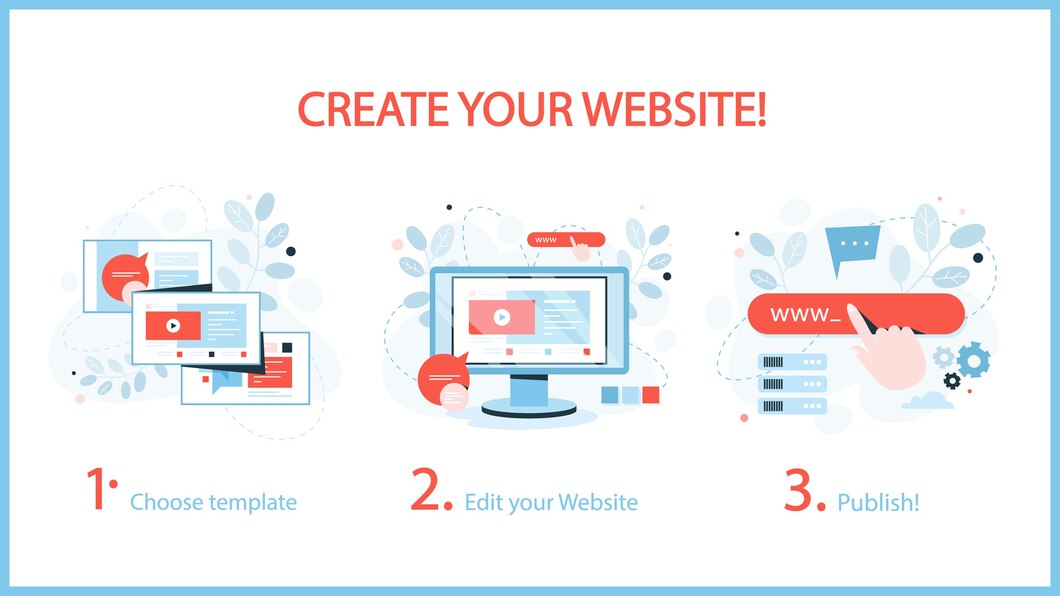How to Create a Website: Step-by-Step Instructions for Anyone
Table of Contents
- Understanding the Basics
- Choosing the Right Domain Name
- Selecting a Web Hosting Service
- Designing Your Website
- Creating Essential Pages
- Setting Up an Online Store
- Optimizing for Search Engines
- Testing and Launching Your Website
- Promoting Your Website
- Conclusion
Understanding the Basics
Creating a website has never been easier. With just a few steps, you can have your platform up and running, whether you’re launching a personal blog or an e-commerce website. In this guide, we will explore how to create a website from scratch, making sure to cover everything you need to know. Let’s dive in!
Choosing the Right Domain Name

Your domain name is your website’s address on the internet. A good domain name is easy to remember and reflects your brand or purpose. Here are some tips for choosing the perfect domain name:
- Keep it short and simple: Aim for a name that is easy to spell and pronounce.
- Include your primary keywords: If you are creating an online store, consider including “store” or “shop” in your domain. For example, “BestGadgetsStore.com.”
- Make it memorable: Your domain should stick in the minds of your visitors.
- Check availability: Use domain registration sites like GoDaddy or Namecheap to see if your desired name is available.
Selecting a Web Hosting Service
Web hosting is essential for getting your website online. A good hosting service will keep your site accessible and secure. Here are popular options to consider:
- Shared Hosting: Ideal for beginners; cost-effective but can be slow if traffic increases. Companies like Hostinger provide excellent services for web hosting
- VPS Hosting: More resources and better performance suited for growing websites.
- Dedicated Hosting: Best for large businesses that need maximum control and resources.
- Cloud Hosting: Flexible and scalable; great for websites with fluctuating traffic.
Make sure to choose a hosting provider that offers good support and easy scalability.
Designing Your Website
When it comes to how to create a website, design plays a vital role in user experience. Here are a few ways to build an attractive website:
Choose a Website Builder
- WordPress: Highly customizable and has numerous themes and plugins available.
- Wix: User-friendly, drag-and-drop interface that’s great for beginners.
- Shopify: Ideal for setting up an online store with built-in e-commerce features.
Pick a Template
Select a template that suits your brand. Most website builders offer a variety of templates categorized by industry.
Customize Your Design
You can modify colors, fonts, and layouts. Ensure that your design is responsive, meaning it looks good on both desktop and mobile devices.
Creating Essential Pages
Every website requires a few essential pages. Here’s what you need to include:
- Home Page: Your landing page that introduces visitors to what you offer.
- About Page: A page detailing who you are and your values.
- Contact Page: Include a contact form, phone number, and email for customer inquiries.
- Products/Services Page: Showcase what you are selling or the services you provide.
- Privacy Policy Page: A must-have for e-commerce websites, outlining how user data is handled.
Setting Up an Online Store
If you intend to start online selling, setting up an online store requires additional steps:
Choose an E-commerce Platform
- Shopify: Great for dedicated online stores with payment processing.
- WooCommerce: A WordPress plugin that allows you to sell physical and digital products effortlessly.
Add Products
Make sure to include high-quality images and detailed descriptions. Include important information such as size, color, and pricing.
Set Up Payment Methods
Integrate secure payment gateways like PayPal, Stripe, or credit card processing systems to allow customers to pay easily.
Optimizing for Search Engines
Optimizing your website is crucial for attracting traffic. Here are some foundational SEO practices:
- Use Keywords: Incorporate relevant keywords such as “store website” or “e-commerce website” naturally within your content.
- Meta Tags: Write compelling title tags and meta descriptions for every page.
- Alt Text for Images: Include descriptions“`markdown
How to Create a Website: Your Comprehensive Guide to Building an Online Store
How to Create a Website: A Step-by-Step Guide to Start Online Selling
Table of Contents
- Understanding Your Purpose
- Choosing the Right Platform
- Selecting a Domain Name
- Designing Your Store Website
- Adding Products and Content
- Setting Up Payment Options
- Optimizing for SEO
- Launching Your E-Commerce Website
- Promoting Your Online Store
- FAQs
Understanding Your Purpose
Before diving into how to create a website, it’s crucial to understand your purpose. Are you looking to start an online store, showcase your portfolio, or share your thoughts through a blog? Knowing your end goal will guide your decisions. For instance, if you’re leaning toward an e-commerce website, your design, functionality, and features will be significantly different compared to a personal blog.
Choosing the Right Platform
Selecting the correct platform is one of the most vital steps in the process. Here are some popular options:
- Shopify: Ideal for those focused solely on e-commerce. It’s designed for online selling, enabling you to set up a store with numerous apps and themes.
- WordPress: A flexible platform suitable for various types of websites. With WooCommerce, it can be transformed into a fully functional online store.
- Wix: A user-friendly platform that allows drag-and-drop editing for those unfamiliar with codes.
- Squarespace: Offers beautiful design templates that are great for visually stunning online stores.
Each platform has its own pros and cons, so consider what features you need for your store website.
Selecting a Domain Name
Your domain name will be your website’s online identity. Choose something that reflects your brand and is easy to remember. Here are some tips for selecting a domain name:
- Keep it short: Avoid lengthy names that can be hard to type.
- Make it memorable: Aim for something that resonates with your target audience.
- Use keywords: If possible, include relevant keywords that describe your business, like “online store” or “fashion e-commerce”.
Once you have a few ideas, check their availability on various domain registrars such as Namecheap or GoDaddy.
Designing Your Store Website
Design plays a significant role in how users interact with your site. A well-crafted layout keeps visitors engaged and encourages them to make purchases. When designing your online store:
- Choose a clean layout: Avoid clutter, and keep navigation simple to improve user experience.
- Use high-quality images: Quality visuals showcase your products effectively, enhancing appeal.
- Ensure mobile responsiveness: With many users shopping on mobile, ensure your website functions smoothly on all devices.
Consider using tools and templates available on your chosen platform to streamline this process.
Adding Products and Content
Once your design is in place, it’s time to add products. Ensure each product listing is clear and detailed:
- Use descriptive titles: Include keywords related to your products.
- Write informative descriptions: Explain features, benefits, and usage to guide buyers.
- Include specifications and prices: Ensure transparency for potential customers.
Additionally, consider adding blog content that gives value to your audience, such as styling tips or industry news, which can help improve your SEO and establish authority in your niche.
Setting Up Payment Options
Offering multiple payment options is essential to accommodate different customer preferences. Consider popular options like:
- Credit/Debit cards
- PayPal
- Apple Pay or Google Pay
- Bank transfers
Make sure your payment gateway is secure, as customers will want assurance their information is safe.
Optimizing for SEO
To ensure your online store reaches its target audience, implementing SEO best practices is crucial. Here are some effective strategies:
- Keyword research: Use tools like Google Keyword Planner to find relevant keywords that customers might search for related to your products.
- Optimize meta titles and descriptions: Ensure that every page has SEO-friendly titles and descriptions that include primary keywords like “e-commerce website.”
- Use alt text for images: Describe your images using keywords to enhance visibility in search engines.
- Internal linking: Link between pages on your website to improve user navigation and distribute page authority.
For more information on SEO, check resources like Moz and Search Engine Journal.
Launching Your E-Commerce Website
Once everything is set, do a final review of your website. Test all functionalities, ensure your payment processing is working, and double-check your content.
When you’re ready, hit that launch button! Announce your website on social media, reach out to friends and family, and consider using email marketing to inform potential customers.
Promoting Your Online Store
After launching, actively promote your online store to attract visitors. Consider the following marketing strategies:
- Social Media Marketing: Create business profiles on platforms like Facebook, Instagram, and Twitter to connect with your audience.
- Email Marketing: Build an email list and send newsletters with promotions or product launches.
- Content Marketing: Continue creating valuable content that attracts visitors and establishes your brand as an expert in the industry.
- Pay-Per-Click Advertising: Use Google Ads or Facebook Ads to target potential customers based on their interests and demographics.
FAQs
Q: How much does it cost to create a website?A: Costs can vary widely based on the platform you choose and whether you hire professionals. Budget for domain registration, hosting, and any platform fees.
Q: Is it necessary to hire a web developer?A: Not necessarily. Many platforms offer user-friendly designs that allow non-technical users to create a website. However, a developer can help with more complex customizations.
Q: What are the essential features of an online store?A: Key features include product listings, a shopping cart, secure payment options, and customer reviews.
Q: Can I use social media to sell my products?A: Yes! Platforms like Instagram and Facebook have integrated shopping features that allow you to showcase and sell your products directly.


Pingback: How to start selling on Amazon.? - Hrrsh Consultancy Private Limited
Your blog never disappoints! This piece was especially thought-provoking—it gave me a fresh perspective and plenty of ideas to explore. Thank you for consistently delivering high-quality content!
Thank you so much for your kind words! Your support and feedback mean a lot to me.
This was such an informative read! I appreciate the way you’ve structured the content, making it so easy to follow and understand. Keep sharing such valuable insights!
I’m thrilled to hear that this piece resonated with you and sparked new ideas. Thank you so much for your valuable feedback.
I really appreciate the effort you put into making your content so valuable. This was an excellent read, and I’ve taken away some great points!
Thank you so much for appreciating us.
This article was an absolute pleasure to read! Your way of explaining complex concepts in such a simple and engaging manner is truly commendable. Keep up the fantastic work!
Thank you so much for giving your valuable time to share your valuable feedback for us.
This was such an informative read! I appreciate the way you’ve structured the content, making it so easy to follow and understand. Keep sharing such valuable insights!
Thank you so much. it means a lot for us.
Did You Know? Cloudways makes cloud hosting a breeze, giving you a fast, friendly platform to build and grow your online presence.
Excellent read! Managing cloud servers can feel daunting, but platforms like Cloudways make it effortless without sacrificing performance. Their approach to simplifying server management while ensuring scalability is spot-on—highly recommend for anyone craving a hassle-free hosting experience. Keep the great content coming!